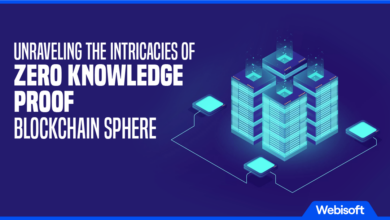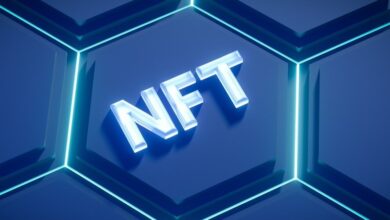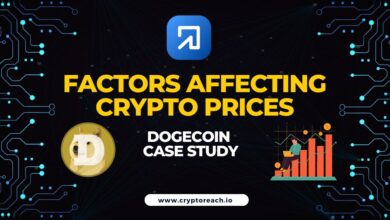
How to Read Crypto Whitepapers to Identify Strong Projects
How to Read Crypto Whitepapers to Identify Strong Projects is a crucial skill for navigating the dynamic crypto landscape. Understanding the nuances of a whitepaper, from its technical details to community engagement, can significantly improve your investment decisions. This guide dives deep into the essential elements to evaluate promising projects.
Crypto whitepapers are more than just marketing documents; they are blueprints for new ventures. They often Artikel the core technology, team, and vision of a project. By learning how to critically assess these documents, you can identify strong projects with potential and avoid those with weak foundations.
Introduction to Crypto Whitepapers
A crypto whitepaper is a document outlining a cryptocurrency project’s purpose, technical details, and future plans. It serves as a foundational document, explaining the project’s vision, technology, team, and roadmap to potential investors, developers, and the wider community. Crucially, it’s a key tool for understanding the core mechanics and potential of a crypto project before committing resources or investing.Whitepapers are essential for conveying the project’s core value proposition, providing transparency and allowing potential users to make informed decisions.
They’re vital for attracting developers, investors, and community members, laying the groundwork for project success. The quality and comprehensiveness of a whitepaper often reflect the overall maturity and potential of the project.
Types of Crypto Projects and Their Whitepapers
Understanding the diverse nature of crypto projects helps in recognizing the varying purposes and structures of their whitepapers. Different types of crypto projects often require different levels of technical detail and emphasis on various aspects.
| Type of Project | Purpose of Whitepaper | Typical Sections |
|---|---|---|
| DeFi (Decentralized Finance) | Explains the project’s proposed decentralized financial protocols, highlighting the technical solutions to traditional financial issues. It details the tokenomics, smart contracts, and overall architecture of the platform. | Introduction, Problem Statement, Proposed Solution, Technical Architecture, Tokenomics, Team, Roadmap, Conclusion |
| NFTs (Non-Fungible Tokens) | Artikels the creation, utility, and application of unique digital assets. The whitepaper explains the token’s functionality, use cases, and potential for various applications, such as digital art, collectibles, or in-game items. | Introduction, Concept & Technology, Use Cases, Marketplace Design, Tokenomics, Roadmap, Team, Conclusion |
| Stablecoins | Details the mechanisms for maintaining a stable value pegged to a fiat currency or another asset. The document explains the reserve mechanisms, algorithms, and security protocols used to maintain stability. | Introduction, Problem Statement, Proposed Solution, Technical Architecture, Stability Mechanisms, Security, Tokenomics, Team, Roadmap, Conclusion |
Importance of Reading Crypto Whitepapers
Reading crypto whitepapers is critical for potential investors and stakeholders. It allows for a thorough understanding of the project’s potential, technical feasibility, and overall viability. The document provides a comprehensive overview, enabling informed decisions about participation or investment.Potential investors can evaluate the project’s risk factors, identify the team’s expertise, and assess the long-term potential based on the information presented.
It’s a crucial step in the due diligence process, preventing costly errors or misjudgments. By understanding the intricacies of a project through its whitepaper, investors can determine if the project aligns with their investment goals and risk tolerance.
Identifying Project Fundamentals: How To Read Crypto Whitepapers To Identify Strong Projects

Source: obiex.finance
Decoding a crypto project’s true potential often hinges on understanding its core mechanics. A meticulously crafted whitepaper can illuminate the project’s innovative technology, dedicated team, and sustainable economic model. However, a superficial glance can easily mask flaws or vulnerabilities. This section delves into crucial elements for evaluating the substance behind the hype, ensuring you’re not just chasing promises.Understanding the project’s underlying technology and innovation is critical.
A strong project demonstrates a novel approach, clear technical specifications, and potential for scalability. Weak projects might rely on existing technologies with limited improvements or lack the technical depth to achieve their goals. Careful examination of the whitepaper’s technical details is paramount.
Core Technology and Innovation
The core technology and innovation of a project are the foundation upon which its success is built. A strong project clearly articulates its novel technical solution, while a weak project often glosses over critical details or relies on existing, less-than-optimal technologies. Examine the whitepaper’s technical specifications for concrete examples of how the project’s innovation addresses a real problem or opportunity.
- Strong Example: A project developing a decentralized exchange (DEX) with a novel approach to order matching, potentially improving transaction speed and reducing slippage. The whitepaper would detail the algorithms, data structures, and security measures in place.
- Weak Example: A project claiming to revolutionize blockchain technology but offering vague descriptions of its innovative features without specific technical details or proofs-of-concept.
Team and Advisors
The individuals behind a project are essential to its success. A strong team comprises experienced developers, strategists, and marketers with demonstrable track records in the relevant fields. A strong advisory board adds credibility and strategic guidance. A weak team may lack the expertise or experience to execute the project’s vision. Assess the backgrounds, experience, and network of the team and advisors.
- Strong Example: A team comprised of experienced blockchain developers with successful projects under their belt and a strong advisory board of industry veterans with proven track records in financial technology.
- Weak Example: A team with limited experience in the blockchain space or a lack of experienced advisors, potentially suggesting a higher risk of project failure.
Tokenomics and Economic Model
A project’s tokenomics and economic model are crucial to its long-term sustainability. This includes understanding the token’s utility, distribution mechanisms, and potential revenue streams. A well-defined tokenomics model is vital to attract investors and sustain community participation.
- Importance: Understanding the tokenomics ensures that the token’s value is tied to the project’s utility and long-term growth prospects. A robust economic model ensures a sustainable funding mechanism and clear pathways for future revenue generation.
| Feature | Strong Tokenomics | Weak Tokenomics |
|---|---|---|
| Token Utility | Clear utility in the project’s ecosystem, potentially serving as a governance or access token. | Limited or unclear utility, potentially leading to decreased value proposition. |
| Distribution | Fair and transparent distribution mechanisms, often aiming to reward early adopters and stakeholders. | Uneven or opaque distribution, raising concerns about potential manipulation or imbalances. |
| Economic Model | Well-defined revenue streams, such as transaction fees or subscription models. | Unclear or nonexistent revenue streams, increasing the risk of project sustainability. |
Evaluating the Project’s Roadmap and Vision
Decoding a crypto project’s potential hinges significantly on its roadmap and vision. A well-defined roadmap provides a tangible framework for the project’s evolution, showcasing realistic milestones and timelines. A compelling vision, on the other hand, paints a vivid picture of the project’s long-term goals, inspiring confidence and highlighting its unique value proposition. Understanding these elements is crucial for discerning a promising project from a fleeting trend.A meticulously crafted roadmap isn’t just a list of tasks; it’s a roadmap to success.
It demonstrates a clear understanding of the challenges and opportunities ahead, and provides a structured plan for navigating them. This plan, in turn, reflects the project team’s capabilities and commitment to execution. A strong roadmap is the key to a successful journey, enabling investors to track progress and gauge the project’s viability.
Evaluating Realistic and Actionable Roadmaps
A robust roadmap is characterized by specific, measurable, achievable, relevant, and time-bound (SMART) goals. Vague or overly ambitious timelines raise red flags. Realistic timelines are essential for assessing the project’s practicality. The roadmap should clearly Artikel the steps needed to achieve each milestone, demonstrating a thoughtful approach to development and execution.
Signs of a Well-Defined and Achievable Roadmap
Projects with well-defined roadmaps typically exhibit several key characteristics. First, the roadmap is detailed, outlining specific tasks and deliverables for each phase. Second, milestones are clearly defined and measurable, allowing for progress tracking. Third, timelines are realistic and achievable, taking into account potential obstacles and dependencies. Fourth, the roadmap is regularly updated and reviewed, reflecting any adjustments and lessons learned.
This iterative process suggests a proactive approach to development and a willingness to adapt. Finally, the roadmap should be accessible and transparent, allowing stakeholders to understand the project’s trajectory.
Importance of a Clear and Compelling Vision
A compelling vision is the guiding star for a project. It articulates the project’s long-term objectives, its impact on the industry, and its unique value proposition. A clear vision instills confidence in investors and motivates the development team. A compelling vision should inspire and paint a vivid picture of the project’s future success. It is the narrative that drives the project forward.
Examples of Strong and Weak Roadmaps and Visions
A strong roadmap might detail the development of a decentralized exchange (DEX) with specific milestones, including the completion of a robust tokenomics model, the development of a user interface, and integration with various wallets. A weak roadmap might only list vague objectives without specifying tasks, timelines, or measurable milestones. A compelling vision might describe the DEX as the future of decentralized finance, revolutionizing the way users interact with financial instruments, while a weak vision might merely state the project’s intention to create a DEX without explaining its unique value proposition.
Project Timelines and Milestones with Progress Indicators
| Milestone | Timeline | Progress Indicator |
|---|---|---|
| Develop core protocol | Q1 2024 | Code repository with commits and tests |
| Implement key features | Q2 2024 | Functional prototypes and unit tests |
| Launch testnet | Q3 2024 | Testnet address and transaction logs |
| Launch mainnet | Q4 2024 | Mainnet deployment and user onboarding data |
This table illustrates how a well-structured roadmap incorporates clear timelines and progress indicators, providing a clear path to project success. Progress indicators allow stakeholders to track the project’s development and measure the achievement of its milestones.
Deciphering strong crypto projects starts with meticulous whitepaper reviews. Look for clear explanations of the team’s expertise and the project’s unique value proposition. Just like understanding how to effectively use garlic and black pepper for pain relief, thorough research is key ( How to Use Garlic and Black Pepper for Pain Relief Effectively ). This careful analysis, combined with market trends and community engagement, will help you identify truly promising ventures in the crypto space.
Assessing the Project’s Community and Ecosystem

Source: amazonaws.com
A strong community is crucial for the success of any cryptocurrency project. Beyond technical merit and compelling whitepaper promises, a thriving community actively engages, provides valuable feedback, and fosters project growth. This vital component often reflects the project’s long-term viability and user adoption potential. Understanding how to assess this aspect is essential for evaluating a project’s overall health and potential ROI.A robust ecosystem, encompassing partnerships and integrations, amplifies a project’s reach and utility.
Analyzing the project’s community and ecosystem provides a holistic view of its strength and potential for sustainable growth, allowing investors to make more informed decisions.
Community Engagement and Growth
A project’s community acts as a crucial feedback loop and driving force behind development. Active engagement demonstrates user interest and support, which are essential for long-term success. Analyzing engagement metrics provides insight into the community’s health and potential for growth.
- Social Media Presence and Activity: Monitoring social media platforms (Twitter, Telegram, Discord) for the frequency and nature of interactions reveals the level of community engagement. High levels of discussion, questions, and responses indicate active participation and a vibrant community.
- Website Traffic and User Growth: Tracking website traffic and user growth provides insights into the project’s visibility and appeal. Consistent increases in website visits and user registrations suggest a growing interest and community expansion.
- Community Forums and Discussion Participation: Examining forum posts, comments, and discussions reveals the level of interaction and the nature of user feedback. Active discussions on technical aspects, roadmap updates, and project improvements indicate a well-engaged community.
- Developer Activity and Response Times: Tracking developer activity, including contributions, updates, and response times to community queries, highlights the project’s responsiveness and dedication to community needs. Fast responses and consistent updates indicate a project that values its users.
Ecosystem and Partnerships
A well-developed ecosystem strengthens a project’s value proposition and expands its reach. Strategic partnerships can bring in new users, technologies, and resources, significantly impacting project growth.
Decoding crypto whitepapers to spot promising projects is crucial. Beyond the technical jargon, you need to look for clear project goals and roadmaps. This often involves understanding the potential of NFTs, which are revolutionizing the digital economy. For a deeper dive into the evolving role of NFTs, check out this insightful article on Understanding the Role of NFTs in the Future Digital Economy.
Ultimately, a strong project will show how its technology aligns with these burgeoning digital assets, making it easier to identify successful projects through their detailed whitepapers.
- Identifying Key Partnerships: Assessing partnerships with other projects, exchanges, or businesses reveals the potential for cross-promotion and collaboration. Partnerships with established entities can significantly enhance a project’s visibility and user base.
- Evaluating Integration Capabilities: Examining the project’s ability to integrate with other platforms and services demonstrates its utility and potential for widespread adoption. Strong integrations suggest broader applications and potential for wider user engagement.
- Assessing Project Adoption by Influencers and Experts: Understanding if the project has gained recognition from prominent figures in the cryptocurrency space can be a strong indicator of its potential. Positive endorsements and reviews from industry experts can boost project credibility.
Indicators of a Thriving Community
A thriving community exhibits characteristics that go beyond simple metrics. It’s a space where users feel heard, valued, and part of a supportive network.
- Positive and Constructive Discussions: A community that engages in positive and constructive discussions, providing valuable feedback, and addressing concerns constructively is a sign of a healthy and supportive environment.
- High Levels of User Engagement: A high level of user engagement indicates interest and enthusiasm for the project. This can be reflected in frequent participation in discussions, community events, and active contributions to the project’s development.
- Strong Sense of Community: A strong sense of community is evident through shared values, mutual respect, and a supportive environment where users feel comfortable expressing their opinions.
Community Metrics and Significance
The following table Artikels key community metrics and their significance in evaluating project viability.
| Metric | Significance |
|---|---|
| Social Media Engagement (likes, shares, comments) | Indicates user interest and potential for wider reach. |
| Forum Activity (posts, replies, discussions) | Reflects community interaction and feedback mechanisms. |
| Website Traffic and User Growth | Shows user interest and project adoption. |
| Developer Response Time | Indicates project responsiveness and community engagement. |
| Partnership Strength | Highlights potential for growth through collaborations and integrations. |
Analyzing the Project’s Security and Audit
Deciphering a crypto project’s security is paramount. A robust security framework isn’t just a desirable feature; it’s a foundational element for trust and longevity. A poorly secured project can quickly lose investor confidence and face severe financial consequences, impacting not only the project itself but potentially the entire crypto ecosystem. Understanding the security measures and audits is crucial for making informed investment decisions.Security audits are critical for verifying the integrity of a cryptocurrency project.
They serve as a crucial checkpoint, assessing the project’s codebase for vulnerabilities and weaknesses. These audits aren’t just about finding flaws; they are a proactive measure to identify potential threats and address them before they can be exploited. Thorough audits can help identify potential loopholes and weak points in the project’s security design, helping to bolster the project’s overall resilience.
Significance of Security Audits
Security audits provide an independent assessment of a project’s security posture. This independent verification is essential because it allows investors to assess the project’s commitment to security beyond marketing claims. By identifying and mitigating potential risks, projects demonstrate a proactive approach to protecting user funds and data. A robust security audit process enhances the project’s credibility and inspires confidence in the project’s commitment to safeguarding user assets.
Reviewing Security Measures
Carefully reviewing a project’s security measures is a key component of due diligence. This involves scrutinizing the architecture, code, and implementation of security protocols. Assessing the project’s codebase for vulnerabilities is essential. This includes examining the smart contracts for potential exploits, examining the project’s API endpoints for weaknesses, and evaluating the overall design for vulnerabilities. Evaluating the protocols and procedures used to secure user funds and data is equally critical.
These procedures should be clearly documented and auditable, allowing investors to assess the project’s commitment to security.
Examples of Well-Executed and Poorly Executed Security Implementations
A well-executed security implementation might involve a multi-signature wallet system for key management, regular security audits by reputable firms, and detailed documentation of security protocols. An example of a project with robust security measures is one that has undergone multiple independent audits by leading security firms and publicly discloses the audit reports.Conversely, a poorly executed implementation might involve a single point of failure for key management, a lack of independent audits, or inadequate documentation of security procedures.
An example of a project with poor security implementation is one that has failed to disclose audit reports or has experienced significant security breaches.
Understanding the Team’s Approach to Security and Audits
The team’s approach to security and audits reveals a lot about the project’s commitment to long-term security. A project with a dedicated security team, a track record of proactive security measures, and a willingness to publicly share audit reports demonstrates a serious commitment to user safety. A lack of transparency or reluctance to share audit results can raise red flags.
The team’s experience and expertise in blockchain security are also crucial indicators.
Comparison of Security Audit Methodologies
| Audit Methodology | Description | Reliability | Cost |
|---|---|---|---|
| Manual Code Review | A security expert manually examines the code for vulnerabilities. | High if done by experienced experts. | High |
| Static Analysis | Tools analyze the code without running it to identify potential vulnerabilities. | Medium to high, depending on the tool and skill of the user. | Medium |
| Dynamic Analysis | Tools analyze the code while it’s running to identify vulnerabilities. | Medium to high. | Medium to high |
| Penetration Testing | Simulated attacks to identify vulnerabilities in the system. | High if done by experienced testers. | High |
Note: Reliability ratings are subjective and depend on the expertise of the auditor and the chosen methodology. Cost varies depending on the complexity of the audit and the chosen methodology.
Understanding the Project’s Tokenomics and Economic Model
Tokenomics, the study of a cryptocurrency project’s token structure and economic mechanisms, is crucial for evaluating its long-term viability. Understanding how tokens function within the project’s ecosystem, and how they drive adoption, is key to identifying potential successes and risks. A well-designed tokenomics model supports the project’s goals, incentivizes participation, and fosters a sustainable ecosystem. Conversely, a poorly designed model can lead to token devaluation, reduced user engagement, and ultimately, project failure.Tokenomics isn’t just about the token itself; it encompasses the entire economic system designed around it.
Decoding crypto whitepapers is key to spotting promising projects. Look for clear explanations of the problem the project aims to solve, and how their proposed solution is innovative. Understanding the impact of IoT on cryptocurrency transaction systems, for example, is crucial. Understanding the Impact of IoT on Cryptocurrency Transaction Systems reveals potential for improved security and scalability.
Ultimately, strong projects will demonstrate a well-defined roadmap, a competent team, and a compelling use case, making them stand out from the crowd in the ever-evolving crypto landscape.
This includes token utility, distribution mechanisms, incentives, and the overall economic model. A thorough analysis of these elements is essential for making informed decisions about a project’s potential.
Token Utility and Functionality
Token utility defines how the token is used within the project. A token with a clear and practical utility beyond mere speculation is more likely to succeed. This utility can range from governance rights to access to exclusive content, or even participation in the project’s platform or services. A well-defined utility often fuels adoption and drives engagement, while a token with limited or unclear use cases might struggle to gain traction.
Token Distribution and Incentives
The way tokens are distributed plays a critical role in a project’s success. Fair and transparent distribution mechanisms, along with effective incentives, can attract early adopters and build a strong community. Conversely, opaque or uneven distributions can lead to distrust and skepticism. Understanding the distribution schedule and the rationale behind it is crucial.
Evaluating Distribution Fairness and Sustainability
Fairness in token distribution is paramount. A token sale with pre-mined tokens, for example, often creates suspicion and mistrust. A project that transparently distributes tokens to various stakeholders, like developers, investors, and the community, can build trust. Furthermore, sustainable tokenomics models should not rely on short-term hype but rather on the long-term value proposition of the project.
A token’s value should be intrinsically tied to the project’s success and utility. Analysis of token distribution schedules should involve scrutiny of the rationale behind the allocation of tokens to different parties. Are the incentives aligned with project goals? Are there provisions for future token adjustments based on project performance?
Examples of Well-Designed and Poorly Designed Tokenomics Models
Numerous projects demonstrate effective tokenomics. For instance, projects with tokenized governance models, allowing holders to vote on important decisions, foster community engagement and create a sense of ownership. This incentivizes participation and helps shape the project’s direction. On the other hand, projects with complex, unclear, or opaque token distribution mechanisms can often struggle. Examples of poorly designed models include those that rely heavily on pre-mined tokens or those with no clear utility for the token.
Analyzing Token Distribution Schedules and Mechanisms
A structured approach to analyzing token distribution schedules is essential. This includes examining the total supply, the allocation of tokens to various parties (development team, investors, community, etc.), the vesting schedule (timeframes for token release), and any planned token burns or inflation adjustments.
| Criteria | Description | Evaluation |
|---|---|---|
| Total Supply | Total number of tokens in circulation | Is it realistic and aligned with the project’s goals? |
| Allocation | Distribution of tokens to various stakeholders | Are the allocations transparent and justifiable? |
| Vesting Schedule | Timeframe for token release | Does it create appropriate incentives and prevent sudden market fluctuations? |
| Token Burns/Inflation | Planned adjustments to the token supply | Are these adjustments aligned with project performance and community goals? |
A thorough analysis of these aspects provides valuable insights into the long-term viability and sustainability of a cryptocurrency project.
Critical Evaluation of Legal and Regulatory Compliance
Navigating the crypto landscape requires a keen understanding of the legal and regulatory frameworks governing it. Projects that ignore or misinterpret these frameworks risk significant legal challenges and reputational damage. A thorough examination of compliance is crucial for evaluating the long-term viability and trustworthiness of any cryptocurrency project.
Importance of Legal Compliance in Crypto
Legal compliance isn’t merely a formality in the crypto space; it’s a fundamental pillar of long-term success. Failure to adhere to relevant laws and regulations can result in hefty fines, legal battles, and even project termination. Projects demonstrating a commitment to compliance build trust with investors and regulators, fostering a positive and stable environment for growth. This proactive approach can significantly reduce the risks associated with operating in a complex and evolving regulatory environment.
Assessing Project Adherence to Regulations, How to Read Crypto Whitepapers to Identify Strong Projects
Evaluating a project’s compliance involves a multi-faceted approach. Scrutinize the whitepaper for explicit statements about legal compliance strategies. Look for details regarding the jurisdiction(s) the project intends to operate in, and how it plans to comply with the specific legal requirements of those areas. Examine whether the project has obtained necessary licenses or registrations. Research any public statements or interactions the project has had with regulatory bodies.
Crucially, verify that the project’s activities align with the legal frameworks of the jurisdictions it operates within.
Examples of Projects Facing Legal Issues
Several crypto projects have faced legal challenges due to inadequate or non-existent compliance strategies. These situations highlight the importance of thorough legal due diligence. Examples include projects that were found to be operating illegally in certain jurisdictions, or those that misrepresented their token offerings as securities without proper registration. The consequences of these violations have ranged from regulatory penalties to complete project closures.
This underscores the crucial role of understanding and adhering to legal frameworks in the crypto industry.
Risks of Operating in Stringent Regulatory Environments
Operating in jurisdictions with stringent regulations presents inherent risks for crypto projects. High compliance costs, extensive reporting requirements, and potentially adversarial regulatory actions can negatively impact a project’s financial viability. Navigating such environments necessitates significant legal expertise and resources. Projects must be prepared to adapt to evolving regulations and maintain a clear understanding of compliance requirements in these regions.
Regulatory Requirements and Implications
The regulatory landscape varies significantly across jurisdictions. This diversity demands a tailored approach to compliance for crypto projects seeking global reach. Understanding these differences is critical for risk mitigation and long-term success.
| Jurisdiction | Key Regulatory Requirements | Implications for Crypto Projects |
|---|---|---|
| United States | Securities Act of 1933, Securities Exchange Act of 1934, and other relevant legislation. | Projects must carefully evaluate whether their tokens are considered securities, and comply with registration requirements if applicable. |
| European Union | Markets in Crypto Assets Regulation (MiCA). | Projects operating within the EU must adhere to MiCA’s requirements, including licensing and reporting obligations. |
| China | Stringent regulations on cryptocurrency exchanges and trading. | Projects operating in China must navigate a complex and often opaque regulatory environment. |
| Singapore | Clearer regulatory guidelines compared to other regions. | Singapore provides a more predictable regulatory framework for crypto projects. |
Final Summary

Source: topteny.com
In conclusion, reading crypto whitepapers effectively is a multi-faceted process. It requires careful analysis of technical aspects, team competence, community strength, and compliance. By employing the strategies Artikeld in this guide, you can confidently navigate the complexities of the crypto space and identify promising projects. Remember that no single aspect guarantees success, but a comprehensive evaluation can greatly increase your chances of spotting the next big thing.
Essential FAQs
What are some common pitfalls to avoid when evaluating a crypto whitepaper?
Overly optimistic projections, vague technical explanations, lack of a clear roadmap, and insufficient information about the team or advisors are all red flags. Be wary of projects that lack transparency or don’t provide concrete evidence of their viability.
How important is the project’s community in evaluating its potential?
A strong, active, and engaged community is a critical indicator of a project’s potential. It signifies early adoption, user interest, and support, which are crucial for long-term success.
What are some examples of red flags in a project’s tokenomics?
Unclear token utility, overly complex or unrealistic token distribution models, and lack of mechanisms for token sustainability are significant red flags. A poorly defined tokenomics section often indicates underlying issues within the project.
How can I determine if a project’s roadmap is realistic?
A realistic roadmap is detailed, actionable, and includes specific timelines and milestones. Look for measurable progress indicators and avoid roadmaps that are overly ambitious or lack concrete steps.






